Step-by-Step Guide to Deploying the Spring PetClinic App in Kubernetes
 Subbu Tech Tutorials
Subbu Tech Tutorials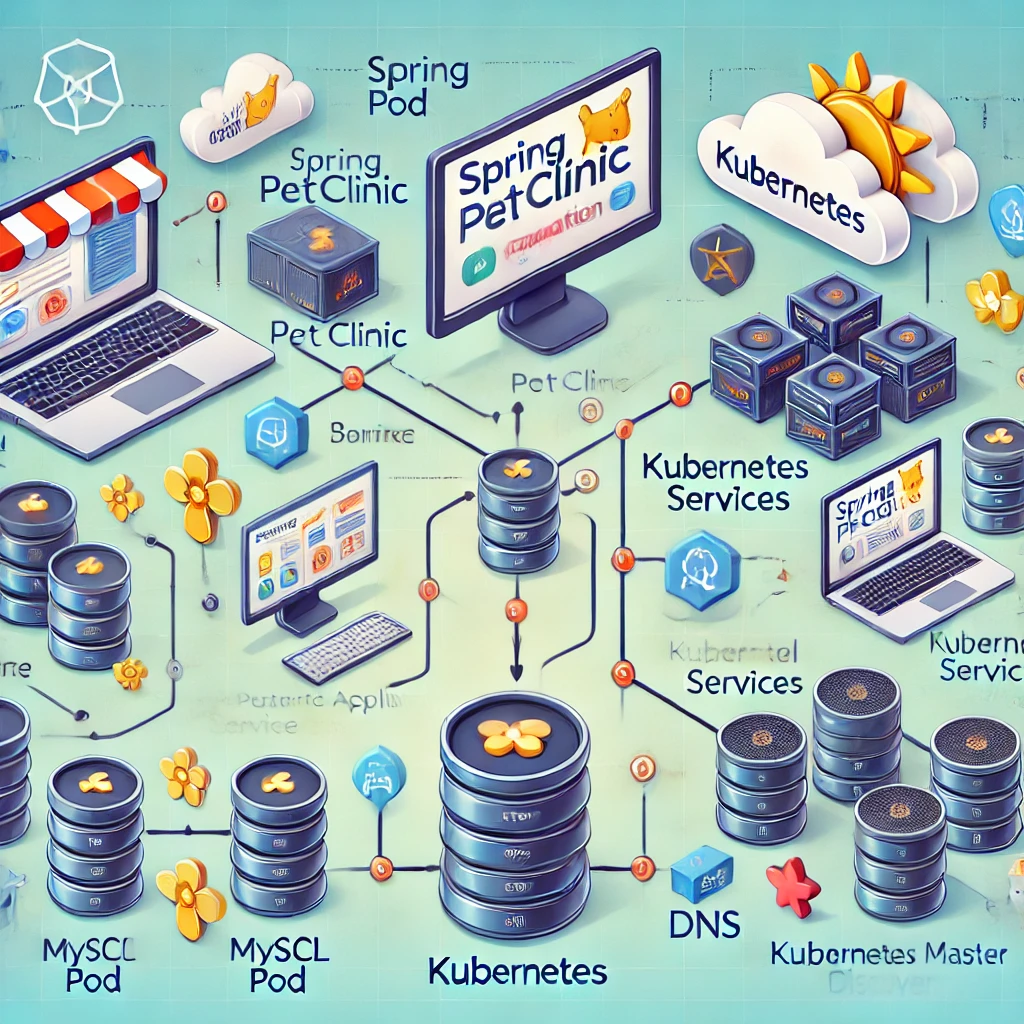
Here's the tree structure for the deployment of the Spring PetClinic app in Kubernetes:
1. Setup Kubernetes Cluster
├── Initialize control plane with kubeadm
└── Add worker nodes to the cluster
2. Prepare Docker Images
├── Build PetClinic app Docker image
└── Push Docker image to DockerHub
3. Deploy MySQL in Kubernetes
├── Create MySQL Deployment
└── Expose MySQL Service
4. Deploy PetClinic Application
├── Create Deployment
└── Expose PetClinic Service (NodePort)
5. Expose Application
├── Access via NodePort
└── Verify application access
6. Test and Verify
├── Run tests on PetClinic
└── Validate database connection
7. Basic Checks to Perform
├── Verify Pod Status
├── Check Logs for Database Connectivity
├── Verify DNS Resolution
├── Ensure MySQL Service is Running
├── Verify MySQL Database Health
├── Check Service Endpoints
├── Test the PetClinic Application
├── Monitor Resources
├── Check Kubernetes Events
└── Automate Health Checks with Probes (Optional)
Set up a K8s Cluster with one master and 2 worker nodes.
Master or Control-Plane Setup:
#:/home/ubuntu# ls
master.sh
#:/home/ubuntu# sh master.sh
-e [INFO] Starting Kubernetes master node setup...
-e [INFO] Running as root user.
-e [INFO] Swap is already disabled.
-e [INFO] Loading necessary kernel modules...
overlay
br_netfilter
-e [INFO] Applying sysctl settings for networking...
-e [INFO] Installing containerd as the container runtime...
-e [INFO] Installing Kubernetes components (kubelet, kubeadm, kubectl)...
-e [INFO] Initializing Kubernetes master node...
Your Kubernetes control-plane has initialized successfully!
To start using your cluster, you need to run the following as a regular user:
mkdir -p $HOME/.kube
sudo cp -i /etc/kubernetes/admin.conf $HOME/.kube/config
sudo chown $(id -u):$(id -g) $HOME/.kube/config
Alternatively, if you are the root user, you can run:
export KUBECONFIG=/etc/kubernetes/admin.conf
You should now deploy a pod network to the cluster.
root@ip-172-31-6-52:/home/ubuntu# kubectl cluster-info
Kubernetes control plane is running at https://172.31.6.52:6443
CoreDNS is running at https://172.31.6.52:6443/api/v1/namespaces/kube-system/services/kube-dns:dns/proxy
Worker Node-1:
#:/home/ubuntu# sh worker.sh
[INFO] Running as root user.
[INFO] Swap is already disabled.
[INFO] Configuring kernel modules and sysctl settings...
overlay
br_netfilter
[INFO] Installing containerd...
[INFO] Configuring containerd to use systemd as the cgroup driver...
[INFO] Installing Kubernetes components...
[INFO] Enabling and starting kubelet service...
[INFO] Kubernetes worker node setup complete.
root@ip-172-31-10-71:/home/ubuntu# kubeadm join 172.31.6.52:6443 --token lfe688.coovikvbbezsrdor --discovery-token-ca-cert-hash sha256:bb6f4d505db272fc17dce99ad05c22f46d31ad2dfc556440ff5bad4e8c02207c
[preflight] Running pre-flight checks
[WARNING FileExisting-socat]: socat not found in system path
[preflight] Reading configuration from the cluster...
[preflight] FYI: You can look at this config file with 'kubectl -n kube-system get cm kubeadm-config -o yaml'
[kubelet-start] Writing kubelet configuration to file "/var/lib/kubelet/config.yaml"
[kubelet-start] Writing kubelet environment file with flags to file "/var/lib/kubelet/kubeadm-flags.env"
[kubelet-start] Starting the kubelet
[kubelet-check] Waiting for a healthy kubelet at http://127.0.0.1:10248/healthz. This can take up to 4m0s
[kubelet-check] The kubelet is healthy after 501.724062ms
[kubelet-start] Waiting for the kubelet to perform the TLS Bootstrap
This node has joined the cluster:
* Certificate signing request was sent to apiserver and a response was received.
* The Kubelet was informed of the new secure connection details.
Run 'kubectl get nodes' on the control-plane to see this node join the cluster.
Do same for worker node-2 also:
Check the Cluster-info and Nodes information:
#:/home/ubuntu# kubectl cluster-info
Kubernetes control plane is running at https://172.31.6.52:6443
CoreDNS is running at https://172.31.6.52:6443/api/v1/namespaces/kube-system/services/kube-dns:dns/proxy
To further debug and diagnose cluster problems, use 'kubectl cluster-info dump'.
#: kubectl get nodes
NAME STATUS ROLES AGE VERSION
ip-172-31-10-71 Ready <none> 12m v1.31.1
ip-172-31-12-137 Ready <none> 8m50s v1.31.1
ip-172-31-6-52 Ready control-plane 22m v1.31.1
Get all resources information in the cluster:
#:/home/ubuntu# kubectl get all -A
NAMESPACE NAME READY STATUS RESTARTS AGE
kube-system pod/coredns-7c65d6cfc9-h7s2k 1/1 Running 0 27m
kube-system pod/coredns-7c65d6cfc9-zlpd4 1/1 Running 0 27m
kube-system pod/etcd-ip-172-31-6-52 1/1 Running 0 27m
kube-system pod/kube-apiserver-ip-172-31-6-52 1/1 Running 0 27m
kube-system pod/kube-controller-manager-ip-172-31-6-52 1/1 Running 0 27m
kube-system pod/kube-proxy-2hmc4 1/1 Running 0 27m
kube-system pod/kube-proxy-fhxt2 1/1 Running 0 13m
kube-system pod/kube-proxy-q6rqs 1/1 Running 0 17m
kube-system pod/kube-scheduler-ip-172-31-6-52 1/1 Running 0 27m
kube-system pod/weave-net-28s2h 2/2 Running 0 17m
kube-system pod/weave-net-6g5wm 2/2 Running 0 13m
kube-system pod/weave-net-qt6rs 2/2 Running 1 (27m ago) 27m
NAMESPACE NAME TYPE CLUSTER-IP EXTERNAL-IP PORT(S) AGE
default service/kubernetes ClusterIP 10.96.0.1 <none> 443/TCP 27m
kube-system service/kube-dns ClusterIP 10.96.0.10 <none> 53/UDP,53/TCP,9153/TCP 27m
NAMESPACE NAME DESIRED CURRENT READY UP-TO-DATE AVAILABLE NODE SELECTOR AGE
kube-system daemonset.apps/kube-proxy 3 3 3 3 3 kubernetes.io/os=linux 27m
kube-system daemonset.apps/weave-net 3 3 3 3 3 <none> 27m
NAMESPACE NAME READY UP-TO-DATE AVAILABLE AGE
kube-system deployment.apps/coredns 2/2 2 2 27m
I have created a name space called ‘dev’
#:/home/ubuntu# kubectl get namespaces
NAME STATUS AGE
default Active 36m
dev Active 93s
kube-node-lease Active 36m
kube-public Active 36m
kube-system Active 36m
Set as dev namespace as default namespace:
# kubectl config set-context --current --namespace=dev
Context "kubernetes-admin@kubernetes" modified.
#:/home/ubuntu# kubectl get pods
No resources found in dev namespace.
#:/home/ubuntu# kubectl get all
No resources found in dev namespace.
Prepare Docker Image for Spring Petclinic Application:
You can fork the project repository from the link below for practice and hands-on experience:
#:git clone https://github.com/SubbuTechTutorials/petclinic-app.git
Cloning into 'petclinic-app'...
remote: Enumerating objects: 10029, done.
remote: Counting objects: 100% (10029/10029), done.
remote: Compressing objects: 100% (4730/4730), done.
remote: Total 10029 (delta 3789), reused 10019 (delta 3782), pack-reused 0 (from 0)
Receiving objects: 100% (10029/10029), 7.57 MiB | 13.45 MiB/s, done.
Resolving deltas: 100% (3789/3789), done.
#: cd petclinic-app/
#:/home/ubuntu/petclinic-app# ls
Dockerfile build.gradle gradle gradlew.bat mvnw.cmd readme.md src
LICENSE.txt docker-compose.yml gradlew mvnw pom.xml settings.gradle
Build PetClinic app Docker image based on Dockerfile:
#: docker build -t <repository>/<image-name>:<tag> <path>
Example
#: docker build -t subbu7677/petclinic-spring-app:v1 .
[+] Building 56.0s (17/17) FINISHED docker:default
=> [internal] load build definition from Dockerfile 0.0s
=> => transferring dockerfile: 453B 0.0s
=> [internal] load metadata for docker.io/library/eclipse-temurin:17-jdk-alpine 1.5s
=> [internal] load metadata for docker.io/library/maven:3.9.4-eclipse-temurin-17-alpine 1.5s
=> [auth] library/maven:pull token for registry-1.docker.io 0.0s
=> [auth] library/eclipse-temurin:pull token for registry-1.docker.io 0.0s
=> [internal] load .dockerignore 0.0s
=> => transferring context: 2B 0.0s
=> [build 1/6] FROM docker.io/library/maven:3.9.4-eclipse-temurin-17-alpine@sha256:794090b9b10405a55c81ffa3dbfcb2332ea988a1 0.0s
=> [runtime 1/3] FROM docker.io/library/eclipse-temurin:17-jdk-alpine@sha256:af68bcb9474937f06d890450e3e2bd7623913187282597 0.0s
=> [internal] load build context 0.1s
=> => transferring context: 9.65MB 0.1s
=> CACHED [build 2/6] WORKDIR /app 0.0s
=> CACHED [build 3/6] COPY pom.xml . 0.0s
=> CACHED [build 4/6] RUN mvn dependency:go-offline -B 0.0s
=> [build 5/6] COPY . . 0.2s
=> [build 6/6] RUN mvn clean package -DskipTests 52.4s
=> CACHED [runtime 2/3] WORKDIR /app 0.0s
=> [runtime 3/3] COPY --from=build /app/target/spring-petclinic-*.jar /app/app.jar 0.3s
=> exporting to image 0.3s
=> => exporting layers 0.3s
=> => writing image sha256:186eaecb9c8d52f35f74d3ed0765502f30b1a970693597458a237f2e06712428 0.0s
=> => naming to docker.io/subbu7677/petclinic-spring-app:v1
Check the Docker Image:
#: docker images
REPOSITORY TAG IMAGE ID CREATED SIZE
subbu7677/petclinic-spring-app v1 186eaecb9c8d 5 minutes ago 376MB
Push Docker image to DockerHub:
# docker login -u subbu7677
Password:
WARNING! Your password will be stored unencrypted in /root/.docker/config.json.
Configure a credential helper to remove this warning. See
https://docs.docker.com/engine/reference/commandline/login/#credential-stores
Login Succeeded
#: docker push subbu7677/petclinic-spring-app:v1
The push refers to repository [docker.io/subbu7677/petclinic-spring-app]
b19fe842d6f4: Pushed
4996fc293a83: Layer already exists
a8a5d72c52b0: Layer already exists
b480ad7bdbcc: Layer already exists
25cc22fd22a0: Layer already exists
e29c7d3c6568: Layer already exists
63ca1fbb43ae: Layer already exists
v1: digest: sha256:996392644653de3d5498bfa2b82ffb3d8d72e840076a2264eb3a39630bea109e size: 1786
Check it in your Docker Hub Account:
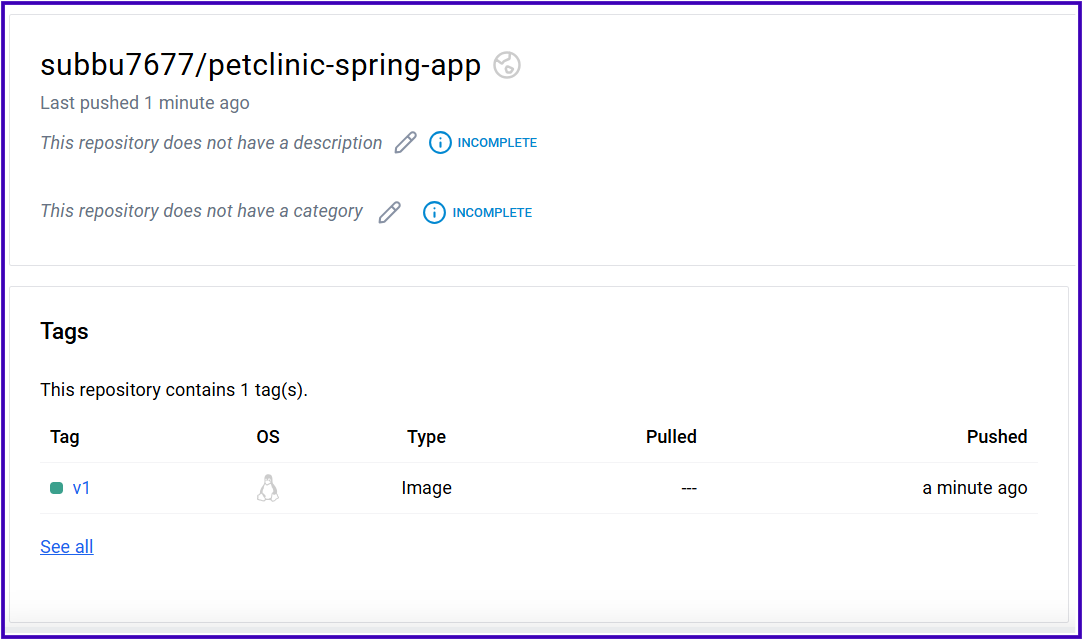
Deploy MySQL in Kubernetes:
Set Up MySQL Database for Spring PetClinic
Create a MySQL deployment and service in the dev namespace.
MySQL Deployment: Deploy a MySQL 8.4 instance with environment variables for MYSQL_USER, MYSQL_PASSWORD, MYSQL_DATABASE, and MYSQL_ROOT_PASSWORD.
MySQL Service: Expose MySQL internally via a ClusterIP service on port 3306 to allow the PetClinic app to connect.
In this step, we set up a MySQL database for the Spring PetClinic application using a Kubernetes deployment and service.
MySQL Deployment: We create a deployment that runs a single MySQL 8.4 instance with environment variables to configure the database (
petclinic) and user credentials. Kubernetes ensures this MySQL instance remains up and can restart automatically if needed.MySQL Service: To allow the Spring PetClinic app to connect to the database, we create a
ClusterIPservice. This exposes MySQL on port3306within the cluster, allowing internal communication between the app and the database.
With this setup, MySQL is fully operational within our Kubernetes cluster, ready to support the Spring PetClinic app.
mysql-deployment.yaml:
apiVersion: apps/v1
kind: Deployment
metadata:
name: mysql-db
namespace: dev
spec:
replicas: 1
selector:
matchLabels:
app: mysql
template:
metadata:
labels:
app: mysql
spec:
containers:
- name: mysql
image: mysql:8.4
ports:
- containerPort: 3306
env:
- name: MYSQL_USER
value: petclinic
- name: MYSQL_PASSWORD
value: petclinic
- name: MYSQL_ROOT_PASSWORD
value: root
- name: MYSQL_DATABASE
value: petclinic
---
apiVersion: v1
kind: Service
metadata:
name: mysql-service
namespace: dev
spec:
type: ClusterIP
ports:
- port: 3306
targetPort: 3306
selector:
app: mysql
Now, apply the mysql-deployment.yaml file.
controlplane ~ ➜ kubectl apply -f mysql-deployment.yaml
deployment.apps/mysql-db created
service/mysql-service created
controlplane ~ ➜ kubectl get all
NAME READY STATUS RESTARTS AGE
pod/mysql-db-7d8cf944c-mcvnq 1/1 Running 0 15s
NAME TYPE CLUSTER-IP EXTERNAL-IP PORT(S) AGE
service/mysql-service ClusterIP 10.108.5.126 <none> 3306/TCP 15s
NAME READY UP-TO-DATE AVAILABLE AGE
deployment.apps/mysql-db 1/1 1 1 15s
NAME DESIRED CURRENT READY AGE
replicaset.apps/mysql-db-7d8cf944c 1 1 1 15s
Inspect the Database Connection:
You can verify whether the Spring PetClinic application is properly communicating with the MySQL database by checking the active database connections.
Connect to the MySQL database inside the Kubernetes cluster:
controlplane ~ ➜ kubectl exec -it mysql-db-7d8cf944c-mcvnq -- /bin/sh
sh-5.1# ls
afs boot docker-entrypoint-initdb.d home lib64 mnt proc run srv tmp var
bin dev etc lib media opt root sbin sys usr
sh-5.1# mysql -u root -p
Enter password:
Welcome to the MySQL monitor. Commands end with ; or \g.
Your MySQL connection id is 28
mysql> SHOW DATABASES;
+--------------------+
| Database |
+--------------------+
| information_schema |
| mysql |
| performance_schema |
| petclinic |
| sys |
+--------------------+
5 rows in set (0.00 sec)
mysql> USE petclinic;
Reading table information for completion of table and column names
You can turn off this feature to get a quicker startup with -A
Database changed
mysql> SHOW TABLES;
+---------------------+
| Tables_in_petclinic |
+---------------------+
| owners |
| pets |
| specialties |
| types |
| vet_specialties |
| vets |
| visits |
+---------------------+
7 rows in set (0.00 sec)
mysql> SELECT * FROM owners;
+----+------------+-----------+-----------------------+-------------+------------+
| id | first_name | last_name | address | city | telephone |
+----+------------+-----------+-----------------------+-------------+------------+
| 1 | George | Franklin | 110 W. Liberty St. | Madison | 6085551023 |
| 2 | Betty | Davis | 638 Cardinal Ave. | Sun Prairie | 6085551749 |
| 3 | Eduardo | Rodriquez | 2693 Commerce St. | McFarland | 6085558763 |
| 4 | Harold | Davis | 563 Friendly St. | Windsor | 6085553198 |
| 5 | Peter | McTavish | 2387 S. Fair Way | Madison | 6085552765 |
| 6 | Jean | Coleman | 105 N. Lake St. | Monona | 6085552654 |
| 7 | Jeff | Black | 1450 Oak Blvd. | Monona | 6085555387 |
| 8 | Maria | Escobito | 345 Maple St. | Madison | 6085557683 |
| 9 | David | Schroeder | 2749 Blackhawk Trail | Madison | 6085559435 |
| 10 | Carlos | Estaban | 2335 Independence La. | Waunakee | 6085555487 |
+----+------------+-----------+-----------------------+-------------+------------+
10 rows in set (0.00 sec)
mysql> SELECT * FROM pets;
+----+----------+------------+---------+----------+
| id | name | birth_date | type_id | owner_id |
+----+----------+------------+---------+----------+
| 1 | Leo | 2000-09-07 | 1 | 1 |
| 2 | Basil | 2002-08-06 | 6 | 2 |
| 3 | Rosy | 2001-04-17 | 2 | 3 |
| 4 | Jewel | 2000-03-07 | 2 | 3 |
| 5 | Iggy | 2000-11-30 | 3 | 4 |
| 6 | George | 2000-01-20 | 4 | 5 |
| 7 | Samantha | 1995-09-04 | 1 | 6 |
| 8 | Max | 1995-09-04 | 1 | 6 |
| 9 | Lucky | 1999-08-06 | 5 | 7 |
| 10 | Mulligan | 1997-02-24 | 2 | 8 |
| 11 | Freddy | 2000-03-09 | 5 | 9 |
| 12 | Lucky | 2000-06-24 | 2 | 10 |
| 13 | Sly | 2002-06-08 | 1 | 10 |
+----+----------+------------+---------+----------+
13 rows in set (0.00 sec)
mysql> SELECT * FROM specialties;
+----+-----------+
| id | name |
+----+-----------+
| 3 | dentistry |
| 1 | radiology |
| 2 | surgery |
+----+-----------+
3 rows in set (0.00 sec)
mysql> SELECT * FROM types;
+----+---------+
| id | name |
+----+---------+
| 5 | bird |
| 1 | cat |
| 2 | dog |
| 6 | hamster |
| 3 | lizard |
| 4 | snake |
+----+---------+
6 rows in set (0.00 sec)
mysql> SELECT * FROM visits ;
+----+--------+------------+-------------+
| id | pet_id | visit_date | description |
+----+--------+------------+-------------+
| 1 | 7 | 2010-03-04 | rabies shot |
| 2 | 8 | 2011-03-04 | rabies shot |
| 3 | 8 | 2009-06-04 | neutered |
| 4 | 7 | 2008-09-04 | spayed |
+----+--------+------------+-------------+
4 rows in set (0.01 sec)
Deploy PetClinic Application:
Create a deployment for the Spring PetClinic application with two replicas.
PetClinic Deployment: Use the image subbu7677/petclinic-spring-app:v1 and set up environment variables to connect to the MySQL service.
PetClinic Service: Expose the application externally via a NodePort service on port 30007 for access from outside the cluster.
In this step, we deploy the Spring PetClinic application in our Kubernetes cluster. We use a deployment with two replicas of the application, ensuring high availability. The app connects to the MySQL database using environment variables for the database URL and credentials.
A NodePort service is used to expose the application on port 30007, allowing external access through any node in the cluster. With this setup, the Spring PetClinic app is now running and accessible in Kubernetes.
As Albert Einstein once said, “Strive not to be a success, but rather to be of value.” This setup ensures the Spring PetClinic app is valuable by maintaining high availability and database connectivity.
petclinic-app-deployment.yaml:
apiVersion: apps/v1
kind: Deployment
metadata:
name: petclinic-app
namespace: dev
spec:
replicas: 2
selector:
matchLabels:
app: petclinic
template:
metadata:
labels:
app: petclinic
spec:
containers:
- name: petclinic
image: subbu7677/petclinic-spring-app:v1
ports:
- containerPort: 8080
env:
- name: MYSQL_URL
value: jdbc:mysql://mysql-service:3306/petclinic
- name: MYSQL_USER
value: petclinic
- name: MYSQL_PASSWORD
value: petclinic
- name: MYSQL_ROOT_PASSWORD
value: root
- name: MYSQL_DATABASE
value: petclinic
---
apiVersion: v1
kind: Service
metadata:
name: petclinic-service
namespace: dev
spec:
type: NodePort
ports:
- port: 8080
targetPort: 8080
nodePort: 30007
selector:
app: petclinic
Now, apply the petclinic-app-deployment.yaml file.
controlplane ~ ➜ kubectl apply -f petclinic-app-deployment.yaml
deployment.apps/petclinic-app created
service/petclinic-service created
controlplane ~ ➜ kubectl get all
NAME READY STATUS RESTARTS AGE
pod/mysql-db-7d8cf944c-mcvnq 1/1 Running 0 116s
pod/petclinic-app-749c6798fd-rw72q 0/1 ContainerCreating 0 7s
pod/petclinic-app-749c6798fd-x4w6l 0/1 ContainerCreating 0 7s
NAME TYPE CLUSTER-IP EXTERNAL-IP PORT(S) AGE
service/mysql-service ClusterIP 10.108.5.126 <none> 3306/TCP 116s
service/petclinic-service NodePort 10.108.39.206 <none> 8080:30007/TCP 7s
NAME READY UP-TO-DATE AVAILABLE AGE
deployment.apps/mysql-db 1/1 1 1 116s
deployment.apps/petclinic-app 0/2 2 0 8s
NAME DESIRED CURRENT READY AGE
replicaset.apps/mysql-db-7d8cf944c 1 1 1 116s
replicaset.apps/petclinic-app-749c6798fd 2 2 0 8s
Expose Application:
Access the Spring PetClinic application using the NodePort URL
http://<node-ip>:30007.Ensure the application communicates with the MySQL database properly by testing the functionality.
PetClinic Application Homepage:
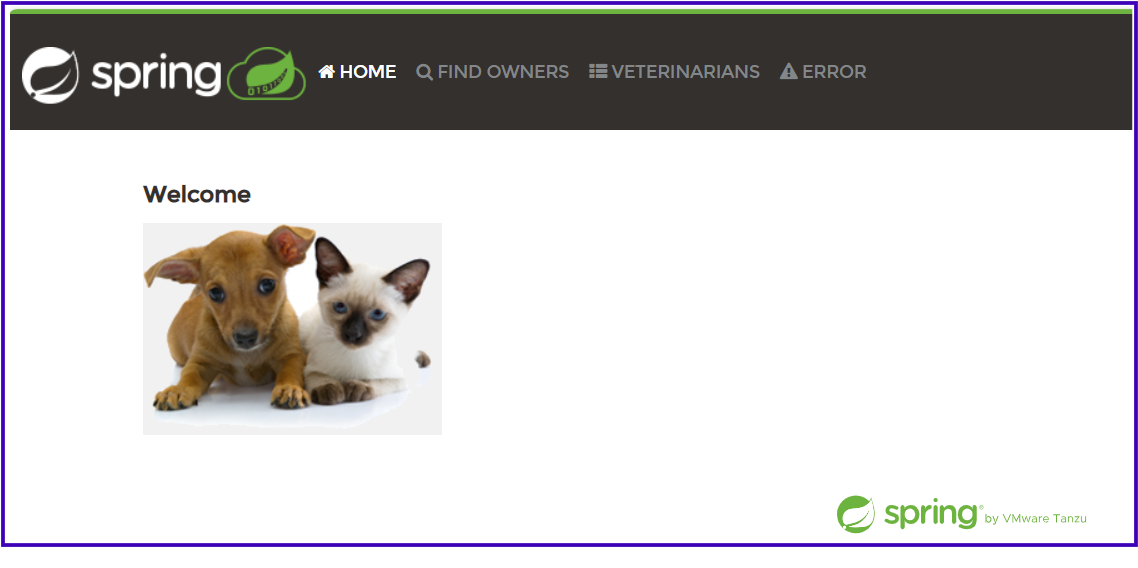
Find Owners Page and details of a particular Owner:
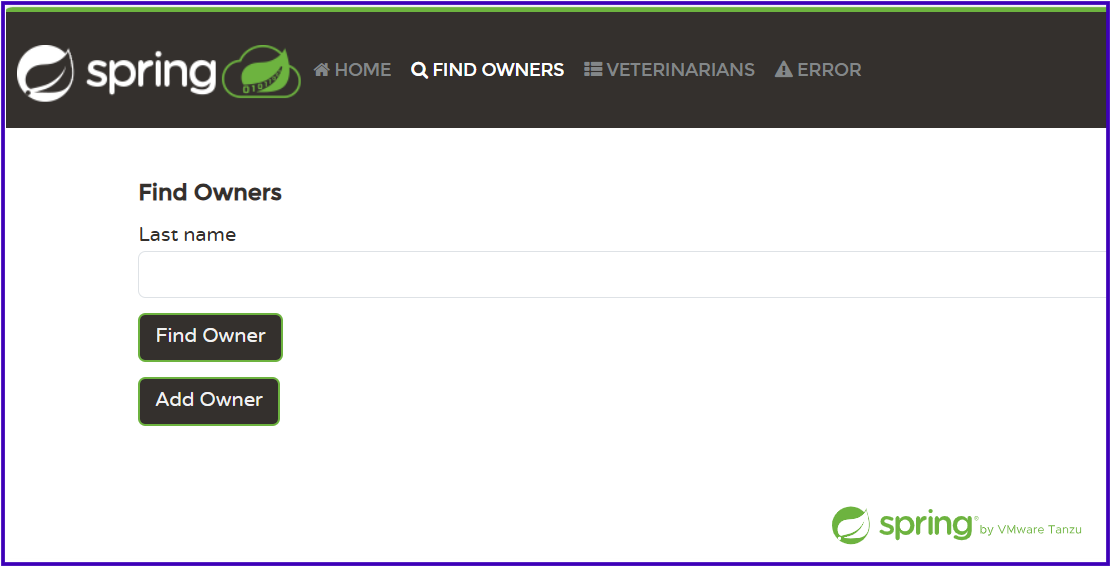
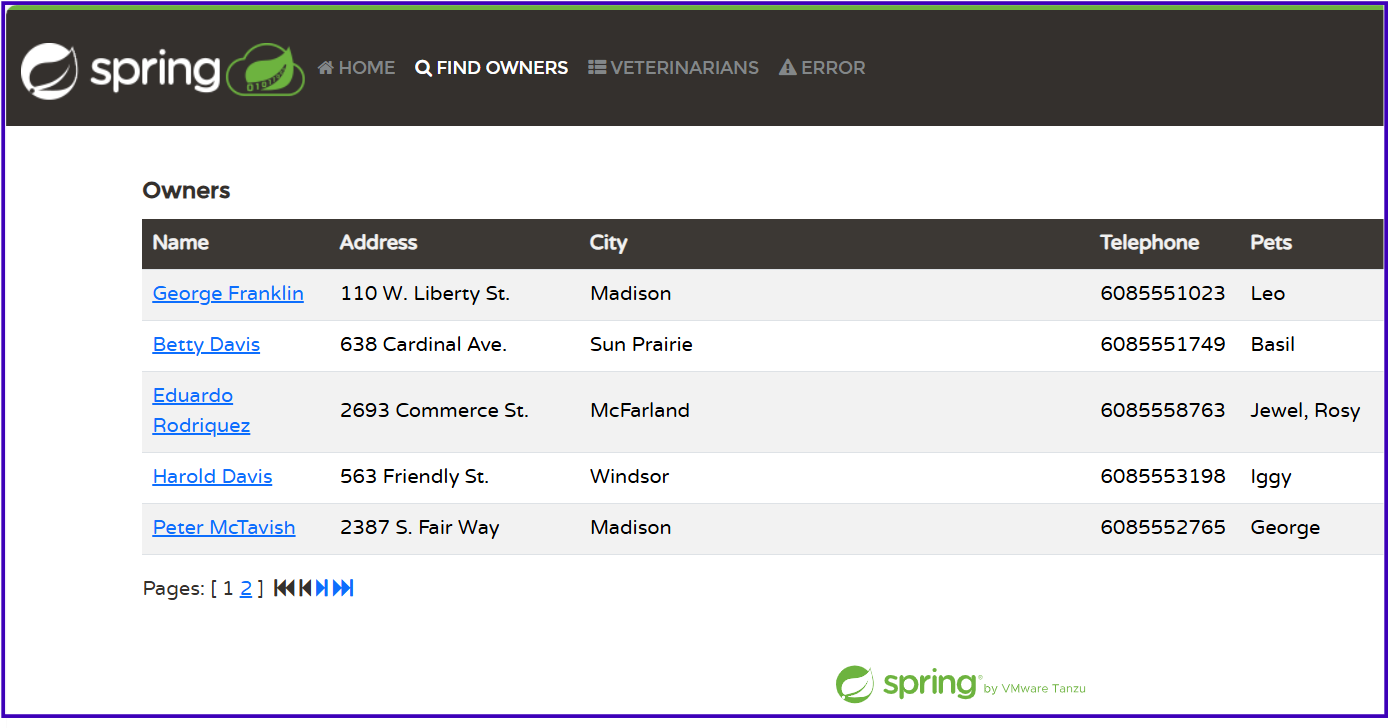
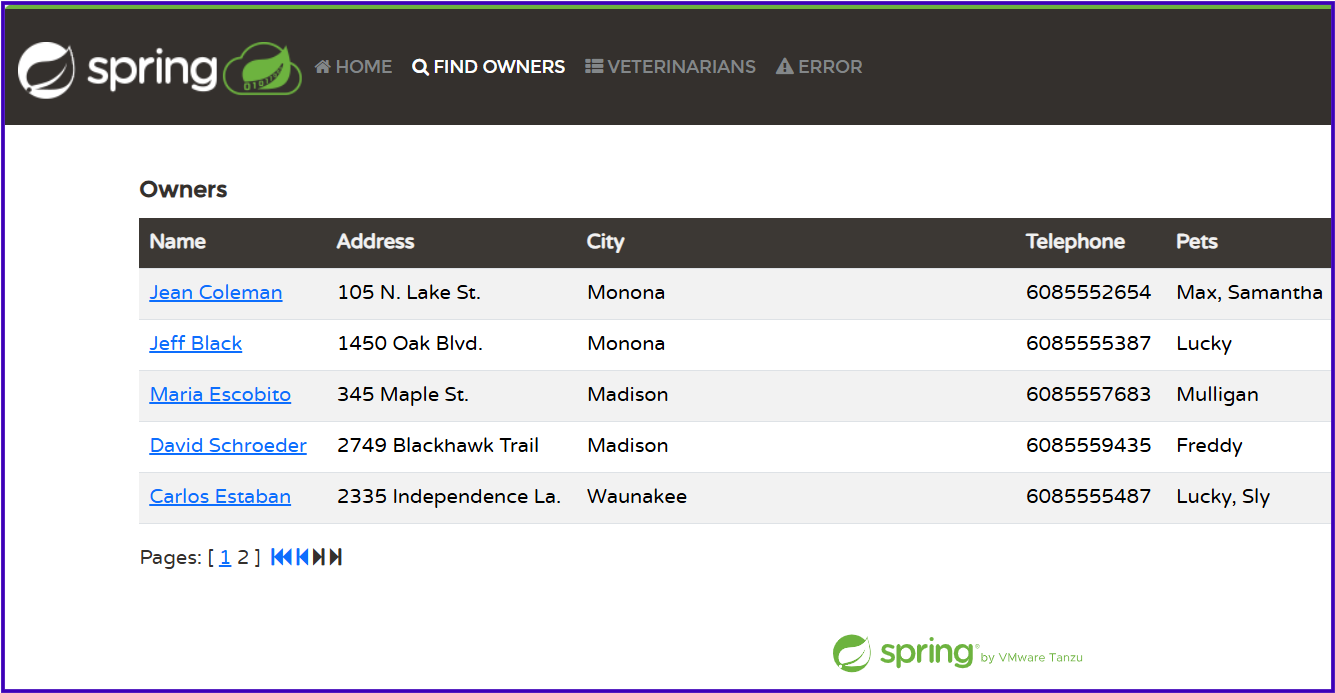
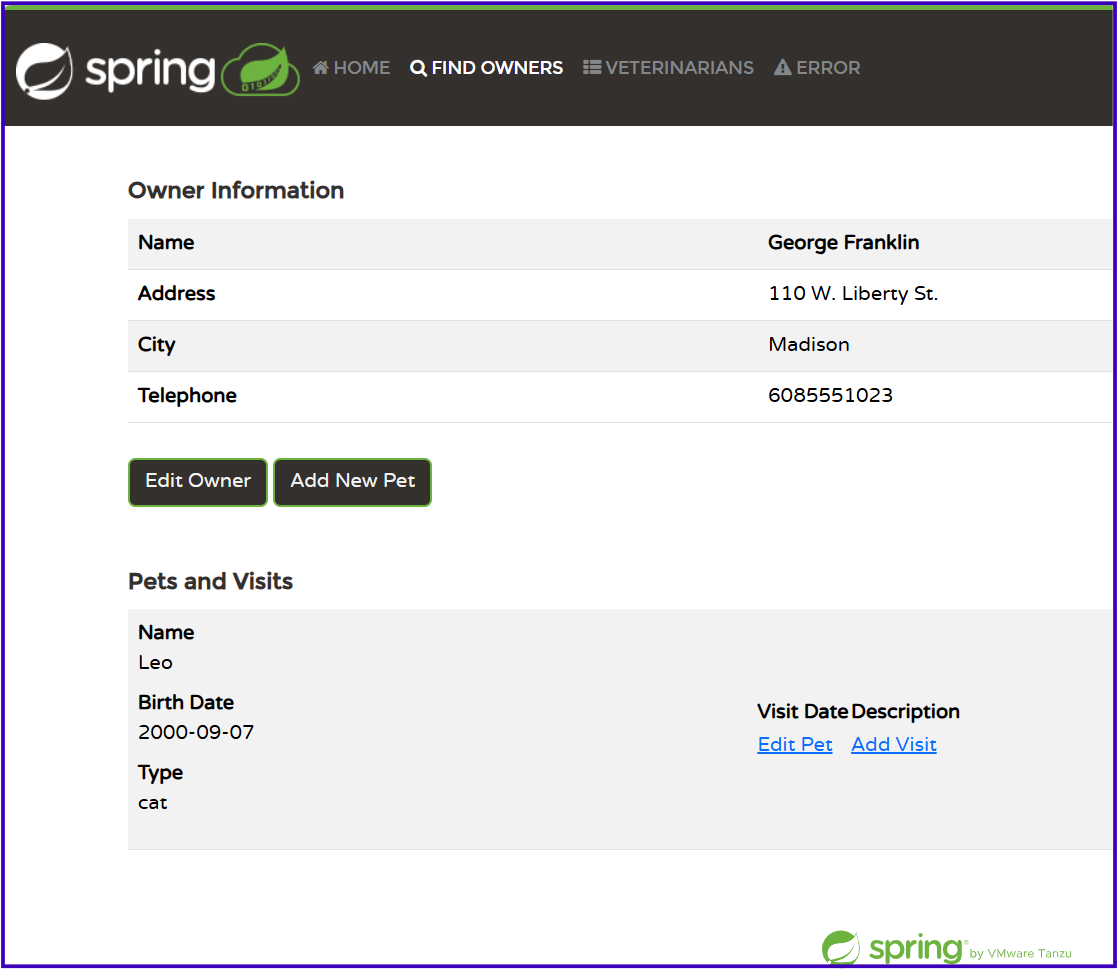
Test and Verify:
Add a new Owner and adding Pets to him:
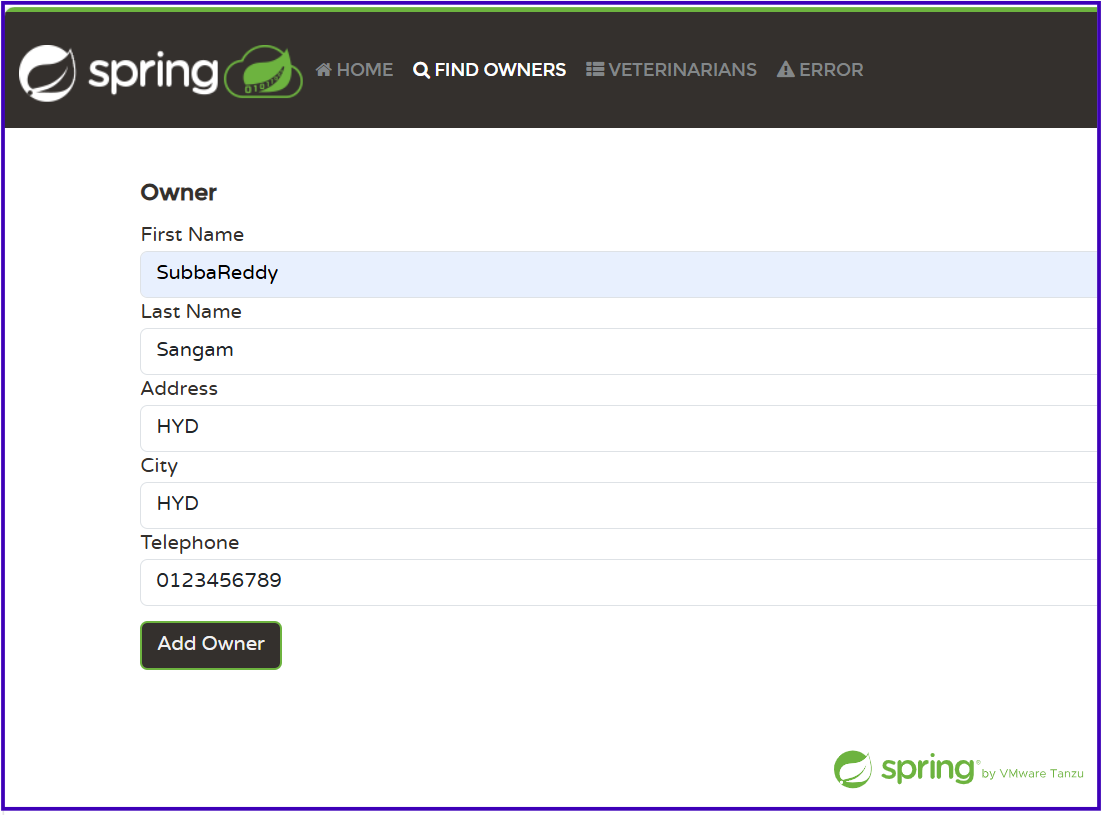
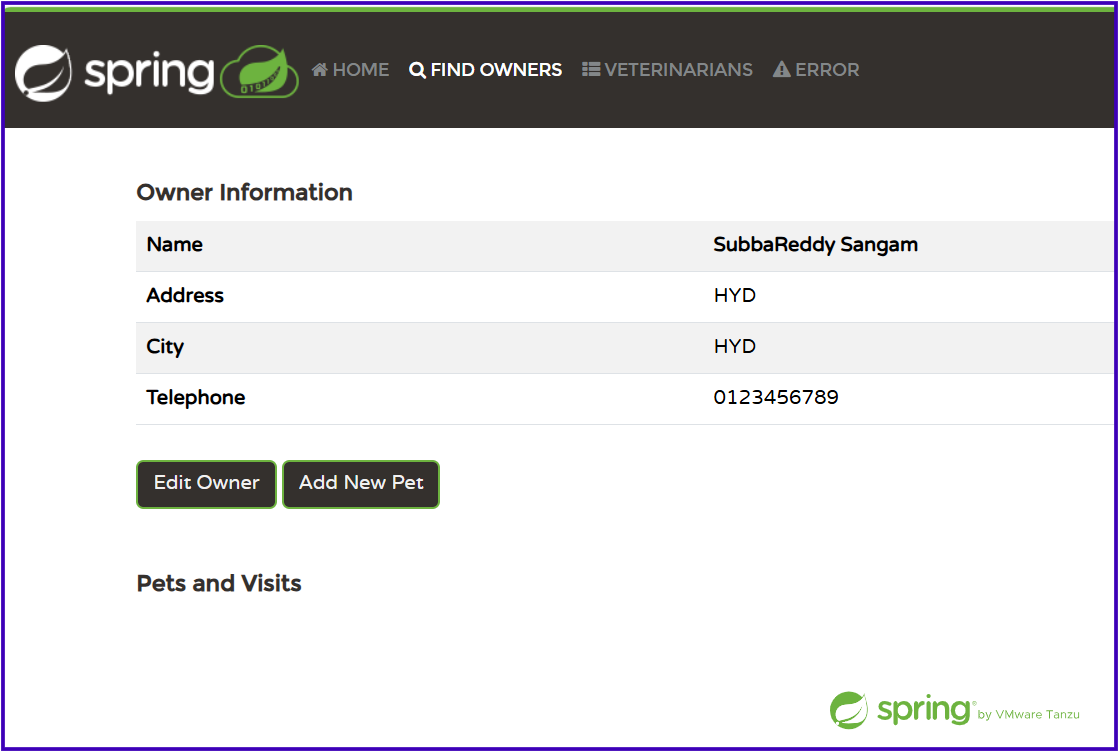
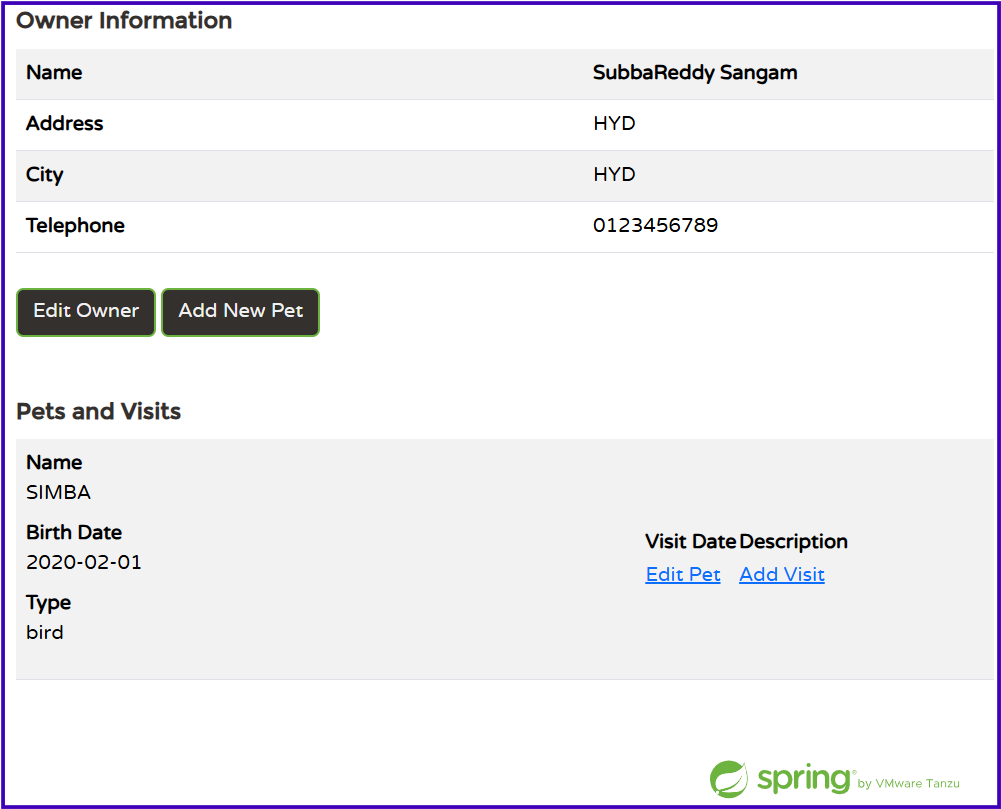
Now you can check in MySQL shell that new user has been added or not:
mysql> SELECT * FROM owners;
+----+------------+-----------+-----------------------+-------------+------------+
| id | first_name | last_name | address | city | telephone |
+----+------------+-----------+-----------------------+-------------+------------+
| 1 | George | Franklin | 110 W. Liberty St. | Madison | 6085551023 |
| 2 | Betty | Davis | 638 Cardinal Ave. | Sun Prairie | 6085551749 |
| 3 | Eduardo | Rodriquez | 2693 Commerce St. | McFarland | 6085558763 |
| 4 | Harold | Davis | 563 Friendly St. | Windsor | 6085553198 |
| 5 | Peter | McTavish | 2387 S. Fair Way | Madison | 6085552765 |
| 6 | Jean | Coleman | 105 N. Lake St. | Monona | 6085552654 |
| 7 | Jeff | Black | 1450 Oak Blvd. | Monona | 6085555387 |
| 8 | Maria | Escobito | 345 Maple St. | Madison | 6085557683 |
| 9 | David | Schroeder | 2749 Blackhawk Trail | Madison | 6085559435 |
| 10 | Carlos | Estaban | 2335 Independence La. | Waunakee | 6085555487 |
| 11 | SubbaReddy | Sangam | HYD | HYD | 0123456789 |
+----+------------+-----------+-----------------------+-------------+------------+
11 rows in set (0.00 sec)
mysql> SELECT * FROM pets;
+----+----------+------------+---------+----------+
| id | name | birth_date | type_id | owner_id |
+----+----------+------------+---------+----------+
| 1 | Leo | 2000-09-07 | 1 | 1 |
| 2 | Basil | 2002-08-06 | 6 | 2 |
| 3 | Rosy | 2001-04-17 | 2 | 3 |
| 4 | Jewel | 2000-03-07 | 2 | 3 |
| 5 | Iggy | 2000-11-30 | 3 | 4 |
| 6 | George | 2000-01-20 | 4 | 5 |
| 7 | Samantha | 1995-09-04 | 1 | 6 |
| 8 | Max | 1995-09-04 | 1 | 6 |
| 9 | Lucky | 1999-08-06 | 5 | 7 |
| 10 | Mulligan | 1997-02-24 | 2 | 8 |
| 11 | Freddy | 2000-03-09 | 5 | 9 |
| 12 | Lucky | 2000-06-24 | 2 | 10 |
| 13 | Sly | 2002-06-08 | 1 | 10 |
| 14 | SIMBA | 2020-02-01 | 5 | 11 |
+----+----------+------------+---------+----------+
14 rows in set (0.00 sec)
Get list of Veterinarians information:
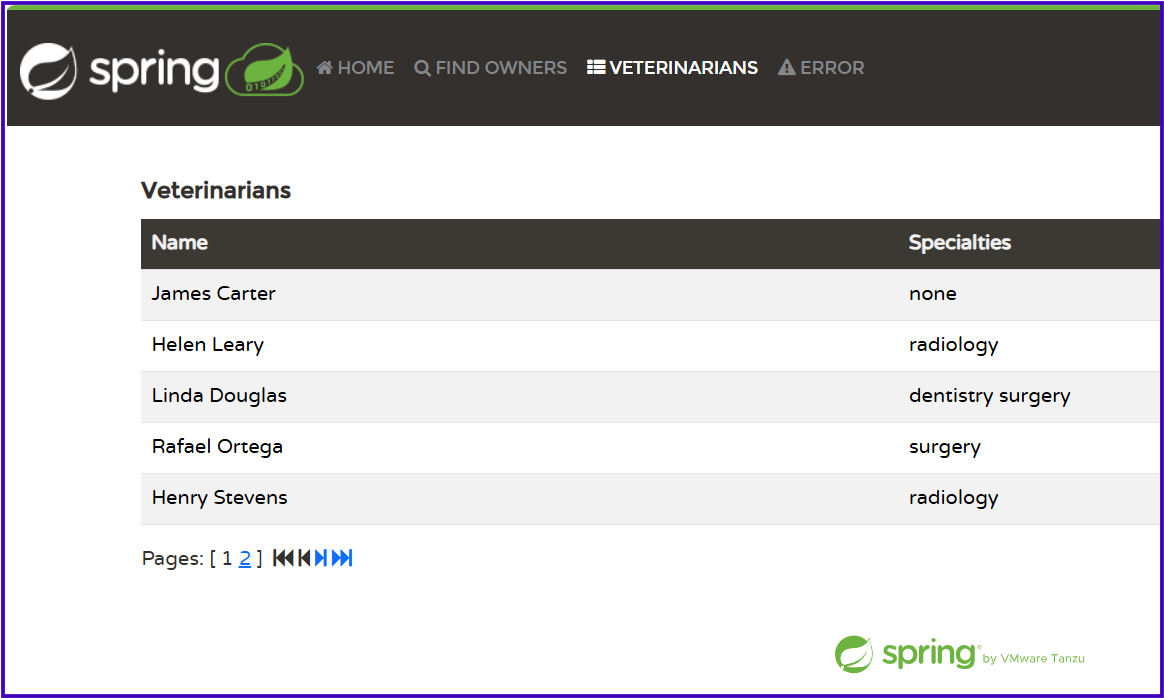
Default Error Handling Page:
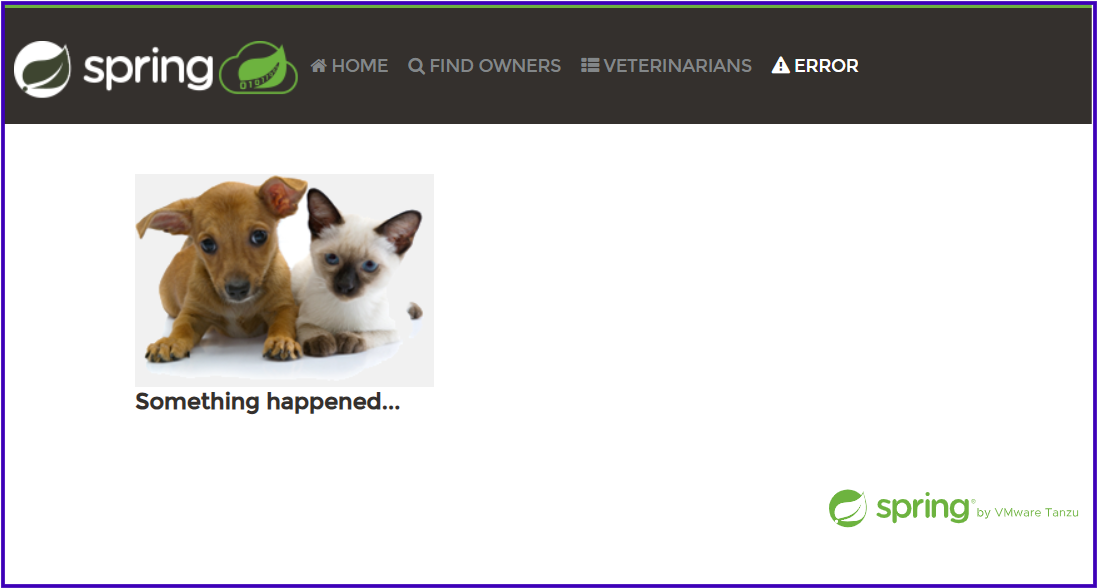
Basic Checks to Perform:
Basic checks to perform when deploying a MySQL database and the PetClinic application in Kubernetes.
1. Verify Pod Status:
The first step after deploying the PetClinic app and MySQL database is to check the status of the pods to ensure they are running properly.
controlplane ~ ➜ kubectl get pods
NAME READY STATUS RESTARTS AGE
mysql-db-7d8cf944c-mcvnq 1/1 Running 0 63m
petclinic-app-749c6798fd-rw72q 1/1 Running 0 61m
petclinic-app-749c6798fd-x4w6l 1/1 Running 0 61m
What to Check:
Ensure both the PetClinic application and MySQL pods are in the
Runningstate.If the pods are stuck in
ContainerCreatingorCrashLoopBackOff, investigate the pod logs to understand the issue.
2. Check Logs for Database Connectivity:
It is crucial to ensure that the PetClinic application has connected to the MySQL database.
kubectl logs <petclinic-pod-name>
Example:
controlplane ~ ➜ kubectl logs petclinic-app-749c6798fd-rw72q
|\ _,,,--,,_
/,`.-'`' ._ \-;;,_
_______ __|,4- ) )_ .;.(__`'-'__ ___ __ _ ___ _______
| | '---''(_/._)-'(_\_) | | | | | | | | |
| _ | ___|_ _| | | | | |_| | | | __ _ _
| |_| | |___ | | | | | | | | | | \ \ \ \
| ___| ___| | | | _| |___| | _ | | _| \ \ \ \
| | | |___ | | | |_| | | | | | | |_ ) ) ) )
|___| |_______| |___| |_______|_______|___|_| |__|___|_______| / / / /
==================================================================/_/_/_/
:: Built with Spring Boot :: 3.3.3
2024-09-29T08:11:26.738Z INFO 1 --- [main] o.s.s.petclinic.PetClinicApplication : Starting PetClinicApplication v3.3.0-SNAPSHOT using Java 17.0.12 with PID 1 (/app/app.jar started by root in /app)
2024-09-29T08:11:26.743Z INFO 1 --- [main] o.s.s.petclinic.PetClinicApplication : No active profile set, falling back to 1 default profile: "default"
2024-09-29T08:11:37.444Z INFO 1 --- [main] .s.d.r.c.RepositoryConfigurationDelegate : Bootstrapping Spring Data JPA repositories in DEFAULT mode.
2024-09-29T08:11:37.851Z INFO 1 --- [main] .s.d.r.c.RepositoryConfigurationDelegate : Finished Spring Data repository scanning in 309 ms. Found 2 JPA repository interfaces.
2024-09-29T08:11:47.839Z INFO 1 --- [main] o.s.b.w.embedded.tomcat.TomcatWebServer : Tomcat initialized with port 8080 (http)
2024-09-29T08:11:48.139Z INFO 1 --- [main] o.apache.catalina.core.StandardService : Starting service [Tomcat]
2024-09-29T08:11:48.139Z INFO 1 --- [main] o.apache.catalina.core.StandardEngine : Starting Servlet engine: [Apache Tomcat/10.1.28]
2024-09-29T08:11:49.132Z INFO 1 --- [main] o.a.c.c.C.[Tomcat].[localhost].[/] : Initializing Spring embedded WebApplicationContext
2024-09-29T08:11:49.135Z INFO 1 --- [main] w.s.c.ServletWebServerApplicationContext : Root WebApplicationContext: initialization completed in 21985 ms
2024-09-29T08:11:54.134Z INFO 1 --- [main] com.zaxxer.hikari.HikariDataSource : HikariPool-1 - Starting...
2024-09-29T08:11:59.543Z INFO 1 --- [main] com.zaxxer.hikari.pool.HikariPool : HikariPool-1 - Added connection com.mysql.cj.jdbc.ConnectionImpl@4fe2dd02
2024-09-29T08:11:59.549Z INFO 1 --- [main] com.zaxxer.hikari.HikariDataSource : HikariPool-1 - Start completed.
2024-09-29T08:12:02.442Z INFO 1 --- [main] o.hibernate.jpa.internal.util.LogHelper : HHH000204: Processing PersistenceUnitInfo [name: default]
2024-09-29T08:12:03.540Z INFO 1 --- [main] org.hibernate.Version : HHH000412: Hibernate ORM core version 6.5.2.Final
2024-09-29T08:12:04.236Z INFO 1 --- [main] o.h.c.internal.RegionFactoryInitiator : HHH000026: Second-level cache disabled
2024-09-29T08:12:08.237Z INFO 1 --- [main] o.s.o.j.p.SpringPersistenceUnitInfo : No LoadTimeWeaver setup: ignoring JPA class transformer
2024-09-29T08:12:12.959Z INFO 1 --- [main] o.h.e.t.j.p.i.JtaPlatformInitiator : HHH000489: No JTA platform available (set 'hibernate.transaction.jta.platform' to enable JTA platform integration)
2024-09-29T08:12:13.240Z INFO 1 --- [main] j.LocalContainerEntityManagerFactoryBean : Initialized JPA EntityManagerFactory for persistence unit 'default'
2024-09-29T08:12:16.343Z INFO 1 --- [main] o.s.d.j.r.query.QueryEnhancerFactory : Hibernate is in classpath; If applicable, HQL parser will be used.
2024-09-29T08:12:38.537Z INFO 1 --- [main] o.s.b.a.e.web.EndpointLinksResolver : Exposing 14 endpoints beneath base path '/actuator'
2024-09-29T08:12:40.333Z INFO 1 --- [main] o.s.b.w.embedded.tomcat.TomcatWebServer : Tomcat started on port 8080 (http) with context path '/'
2024-09-29T08:12:40.538Z INFO 1 --- [main] o.s.s.petclinic.PetClinicApplication : Started PetClinicApplication in 77.602 seconds (process running for 82.329)
What to Look For:
Successful connection logs such as:
HikariPool-1 - Starting...
HikariPool-1 - Start completed.
Any database connection errors or exceptions, such as:
Cannot create PoolableConnectionFactory (Communications link failure)
3. Verify DNS Resolution:
Kubernetes uses DNS for service discovery. Make sure the PetClinic app can resolve the MySQL service via DNS.
Inside the PetClinic pod, use nslookup to verify DNS resolution:
kubectl exec -it <petclinic-pod-name> -- nslookup <mysql-service-name>
Example:
controlplane ~ ➜ kubectl exec -it petclinic-app-749c6798fd-rw72q -- nslookup mysql-service
Server: 10.96.0.10
Address: 10.96.0.10:53
Name: mysql-service.dev.svc.cluster.local
Address: 10.108.5.126
4. Ensure the MySQL Service is Running:
The MySQL service is responsible for allowing the PetClinic application to connect to the database.
Check service status:
controlplane ~ ➜ kubectl get svc
NAME TYPE CLUSTER-IP EXTERNAL-IP PORT(S) AGE
mysql-service ClusterIP 10.108.5.126 <none> 3306/TCP 74m
petclinic-service NodePort 10.108.39.206 <none> 8080:30007/TCP 72m
What to Check:
Ensure the MySQL service is listed and accessible.
Make sure the service type (ClusterIP, NodePort, or LoadBalancer) is set up correctly for the app's needs.
5. Verify MySQL Database Health:
Once the MySQL pod is running, ensure that the database is healthy and functioning correctly.
Connect to MySQL inside the pod:
kubectl exec -it <mysql-pod-name> -- mysql -u <user> -p
Example:
controlplane ~ ➜ kubectl get svc
NAME TYPE CLUSTER-IP EXTERNAL-IP PORT(S) AGE
mysql-service ClusterIP 10.108.5.126 <none> 3306/TCP 78m
petclinic-service NodePort 10.108.39.206 <none> 8080:30007/TCP 76m
controlplane ~ ➜ kubectl get po
NAME READY STATUS RESTARTS AGE
mysql-db-7d8cf944c-mcvnq 1/1 Running 0 78m
petclinic-app-749c6798fd-rw72q 1/1 Running 0 77m
petclinic-app-749c6798fd-x4w6l 1/1 Running 0 77m
controlplane ~ ➜ kubectl exec -it mysql-db-7d8cf944c-mcvnq -- mysql -u petclinic -p
Enter password:
Welcome to the MySQL monitor. Commands end with ; or \g.
Your MySQL connection id is 69
Server version: 8.4.2 MySQL Community Server - GPL
Copyright (c) 2000, 2024, Oracle and/or its affiliates.
Oracle is a registered trademark of Oracle Corporation and/or its
affiliates. Other names may be trademarks of their respective
owners.
Type 'help;' or '\h' for help. Type '\c' to clear the current input statement.
mysql> SHOW DATABASES;
+--------------------+
| Database |
+--------------------+
| information_schema |
| performance_schema |
| petclinic |
+--------------------+
3 rows in set (0.00 sec)
mysql> USE petclinic;
Reading table information for completion of table and column names
You can turn off this feature to get a quicker startup with -A
Database changed
mysql> SHOW TABLES;
+---------------------+
| Tables_in_petclinic |
+---------------------+
| owners |
| pets |
| specialties |
| types |
| vet_specialties |
| vets |
| visits |
+---------------------+
7 rows in set (0.00 sec)
mysql>
What to Check:
Ensure the PetClinic database (
petclinic) and its tables are created successfully.Run queries to verify the data.
6. Check Service Endpoints:
Ensure that Kubernetes is routing traffic correctly between the PetClinic app and MySQL.
kubectl get endpoints <mysql-service-name>
Example:
controlplane ~ ➜ kubectl get svc
NAME TYPE CLUSTER-IP EXTERNAL-IP PORT(S) AGE
mysql-service ClusterIP 10.108.5.126 <none> 3306/TCP 81m
petclinic-service NodePort 10.108.39.206 <none> 8080:30007/TCP 79m
controlplane ~ ➜ kubectl get endpoints mysql-service
NAME ENDPOINTS AGE
mysql-service 10.244.1.2:3306 82m
What to Check:
Confirm that the service has endpoints (i.e., IP addresses of the MySQL pods).
If the endpoints are missing, the service won’t be able to route traffic to the MySQL database.
7. Test the PetClinic Application:
Once deployment is done, ensure the PetClinic application is accessible and functioning correctly:
Access the app via a browser:
http://<node-ip>:<nodePort>
Basic Tests:
Add new owners, pets, and visits via the UI.
Ensure you can view veterinarians and their schedules.
8. Monitor Resources:
Ensure that both MySQL and the PetClinic app are not consuming excessive resources.
Check pod resource usage:
kubectl top pod
Before running the above command, ensure that your Metrics Server pod is up and running.
controlplane ~ ➜ kubectl get pods -n kube-system
NAME READY STATUS RESTARTS AGE
coredns-77d6fd4654-pksdt 1/1 Running 0 112m
coredns-77d6fd4654-wrvh6 1/1 Running 0 112m
etcd-controlplane 1/1 Running 0 113m
kube-apiserver-controlplane 1/1 Running 0 113m
kube-controller-manager-controlplane 1/1 Running 0 113m
kube-proxy-bn59c 1/1 Running 0 112m
kube-proxy-fhpvh 1/1 Running 0 112m
kube-proxy-pdzrm 1/1 Running 0 112m
kube-scheduler-controlplane 1/1 Running 0 113m
metrics-server-587b667b55-kmfs9 1/1 Running 0 61s
Now check pod resource usage:
controlplane ~ ➜ kubectl top pod
NAME CPU(cores) MEMORY(bytes)
mysql-db-7d8cf944c-l2rrq 5m 473Mi
petclinic-app-749c6798fd-lrnsl 2m 315Mi
petclinic-app-749c6798fd-nwb5s 2m 317Mi
What to Check:
Look for high CPU or memory usage.
Ensure there are no resource limits that might affect performance.
9. Check Kubernetes Events:
Review Kubernetes events to troubleshoot any issues related to the deployment.
kubectl get events
controlplane ~ ➜ kubectl get events
LAST SEEN TYPE REASON OBJECT MESSAGE
18m Normal Scheduled pod/mysql-db-7d8cf944c-l2rrq Successfully assigned dev/mysql-db-7d8cf944c-l2rrq to node01
18m Normal Pulling pod/mysql-db-7d8cf944c-l2rrq Pulling image "mysql:8.4"
18m Normal Pulled pod/mysql-db-7d8cf944c-l2rrq Successfully pulled image "mysql:8.4" in 13.831s (13.831s including waiting). Image size: 169786508 bytes.
18m Normal Created pod/mysql-db-7d8cf944c-l2rrq Created container mysql
18m Normal Started pod/mysql-db-7d8cf944c-l2rrq Started container mysql
18m Normal SuccessfulCreate replicaset/mysql-db-7d8cf944c Created pod: mysql-db-7d8cf944c-l2rrq
18m Normal ScalingReplicaSet deployment/mysql-db Scaled up replica set mysql-db-7d8cf944c to 1
17m Normal Scheduled pod/petclinic-app-749c6798fd-lrnsl Successfully assigned dev/petclinic-app-749c6798fd-lrnsl to node02
17m Normal Pulling pod/petclinic-app-749c6798fd-lrnsl Pulling image "subbu7677/petclinic-spring-app:v1"
17m Normal Pulled pod/petclinic-app-749c6798fd-lrnsl Successfully pulled image "subbu7677/petclinic-spring-app:v1" in 9.941s (9.941s including waiting). Image size: 214461451 bytes.
17m Normal Created pod/petclinic-app-749c6798fd-lrnsl Created container petclinic
17m Normal Started pod/petclinic-app-749c6798fd-lrnsl Started container petclinic
17m Normal Scheduled pod/petclinic-app-749c6798fd-nwb5s Successfully assigned dev/petclinic-app-749c6798fd-nwb5s to node01
17m Normal Pulling pod/petclinic-app-749c6798fd-nwb5s Pulling image "subbu7677/petclinic-spring-app:v1"
17m Normal Pulled pod/petclinic-app-749c6798fd-nwb5s Successfully pulled image "subbu7677/petclinic-spring-app:v1" in 10.048s (10.048s including waiting). Image size: 214461451 bytes.
17m Normal Created pod/petclinic-app-749c6798fd-nwb5s Created container petclinic
17m Normal Started pod/petclinic-app-749c6798fd-nwb5s Started container petclinic
17m Normal SuccessfulCreate replicaset/petclinic-app-749c6798fd Created pod: petclinic-app-749c6798fd-nwb5s
17m Normal SuccessfulCreate replicaset/petclinic-app-749c6798fd Created pod: petclinic-app-749c6798fd-lrnsl
17m Normal ScalingReplicaSet deployment/petclinic-app Scaled up replica set petclinic-app-749c6798fd to 2
What to Look For:
- Look for any errors or warnings that could indicate network issues, scheduling problems, or other errors.
10. Automate Health Checks with Probes (Optional):
Ensure your pods stay healthy by configuring liveness and readiness probes.
Example Configuration in a Deployment YAML:
livenessProbe:
httpGet:
path: /actuator/health
port: 8080
initialDelaySeconds: 30
periodSeconds: 10
readinessProbe:
httpGet:
path: /actuator/health
port: 8080
initialDelaySeconds: 30
periodSeconds: 10
"Live as if you were to die tomorrow. Learn as if you were to live forever."
— Mahatma GandhiThank you, Happy Learning!
Subscribe to my newsletter
Read articles from Subbu Tech Tutorials directly inside your inbox. Subscribe to the newsletter, and don't miss out.
Written by
